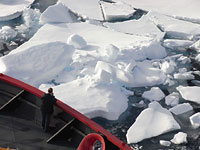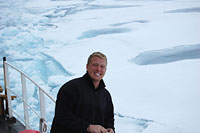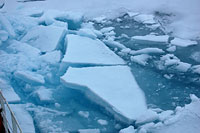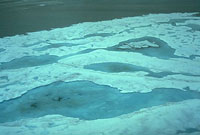

 | |||||||||||||||||
|
|
Journals 2009/2010Jonathan Pazol
August 27, 2009 I think I've mentioned that one of everyone's favorite things to do on the Healy is to go outside and watch the ice. Yes, we're in the Arctic and don't get mail, consistent internet, live TV, daily in-depth news, or much contact with home, but trust me, watching the ice is truly fascinating - and the non-science geeks from the Coast Guard agree. Almost any time of day or night, you can find people up on the bridge, out on the bow, or along the port side (where there is warm air blowing from the vents), watching the differences in textures, colors, patterns, and sizes of the chunks the ship has broken. Everyone here with a camera has probably taken several dozen pictures of it as well - digital cameras are a wonderful invention. The sheer size of the ice is very deceiving. What looks like a small chunk may in fact be 3-4 meters (10-13 feet) long. The photo below of me on the bow gives you some perspective.
I have heard that the Inupiat have as many as 46 different words for snow and ice in their native language. Before coming to the Arctic, I could not understand how that could be possible. In fact, though, there are entire organizations and scientists who have dedicated their careers to studying ice. On this expedition, we have 5 people whose jobs are to monitor and report on the ice for a variety of organizations. Every hour, one of them goes out and takes a photograph of the ice conditions and records a variety of measurements from the bridge - location, temperature, wind speed, etc. Then these are sent and compiled with satellite data to provide reports on ice conditions around the Arctic.
The Science Party has had various lectures about ice and ice science during our nightly seminars, so I wanted to share some of what I've learned. Sea ice, which is different from glacier ice, is classified by its age into "New," "1st Year," and "Old" ice. The basic difference is that New and 1st Year ice have not been present for more than 1 winter, while Old ice has survived a freeze/melt cycle. New ice is generally 0-30 cm (up to 1 foot) thick, is generally dark gray, and looks like oil or grease floating on top of the water. There are a variety of classifications, including frazil, slush, shuga, nilas, and grease. The types of new ice we have seen most out here are grease (an oily-looking surface layer of joined ice needles) and nilas (a thin, elastic crust of ice that moves with the waves and is often striped in appearance).
Young ice, a type of New ice, is a transitional form of ice, and we are not seeing it because we are in the middle of melt season. Most of the ice we are seeing is 1st Year ice. This ice has not survived more than 1 winter, is between 30 cm - 2 m (1-7 feet) thick, is white and blue, may have multiple sharp ridges where floes have come together, fractures and breaks up in a linear pattern, and may have melt ponds on the top. This type of ice is sub-classified as thin, medium, and thick, depending on the thickness. If this ice extends 1 meter (3 feet) above the surface of the water, then there are about 4 meters (13 feet) of ice below.
Old ice, which has survived for more than 1 season, is also sub-classified into 2nd Year ice and Multi-Year ice (MYI). Any 1st Year ice that is still present on October 1st is classified as 2nd Year ice. And after that October 1 represents the "anniversary" of an ice floe's existence. Old ice is thicker than 2 meters (7 feet), is often greenish-blue at the edges, can have high weathered ridges, has few thaw holes within the melt ponds, contains well-developed drainage areas, and often has a brownish algae growth on the underside.
If you're having problems telling the difference between the ice types, don't worry. Every time I think I can identify one of the types, I find it's something else. I figure I have a few more weeks to keep learning. |
||||||||||||||||




